A lot of vegetarians claim that people can get just as much if not more protein without so much as a head nod to the meat industry. Recently we’ve been asking ourselves about our own protein intake, and how well we’re getting by when we shirk meat (not strictly vegetarian ourselves) for vegetarian options. After running a few calculators (ballpark estimates at best), we decided we were actually coming up a bit short.
Yes, we were getting protein from our oatmeal, the occasional bean dish, peanut butter, and the accumulated scant amounts that compile from eating lots of and lots of vegetables. Also, as we’ve said we’re not, strictly speaking, vegetarians (see our posts on behind the curtain). We do, however feel that less meat is a good thing – moderation contributes to better health, cheaper meals, and a greener environment.
We’ve no intention of shaming anyone for declaring themselves obligate carnivores. We have no problems, however, saying that the meat industry is inhumane, corrosive, and very much has aspired to corporate echelons of greed and environmental destruction. Sadly, alternative sources (grass fed, pasture raised) are fewer and far between, and a little pricey to pick up as a staple.
So, nuts, legumes, eggs (from home), and power grains like quinoa. We made a dedicated run to our local bulk food store (for us, this is Winco, a co-op run grocery store that treats its employees very well). Behold the spoils: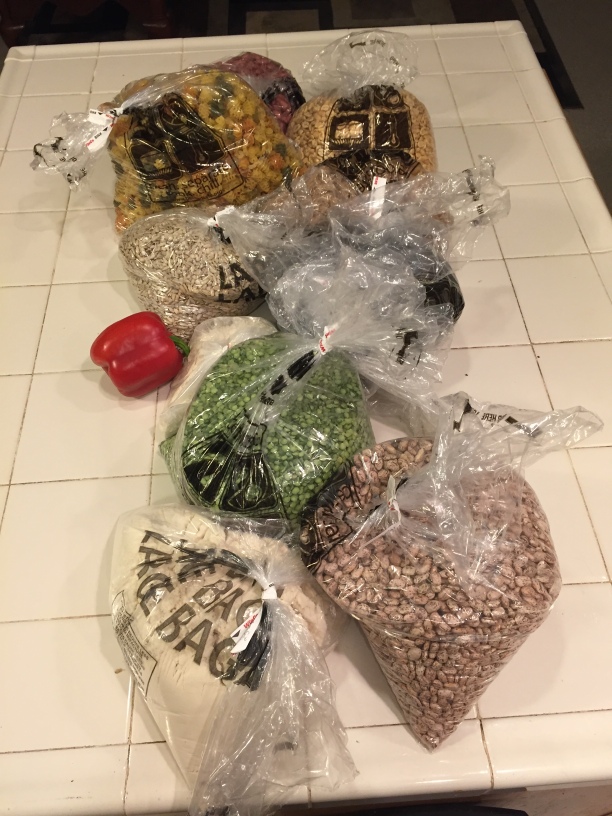
Cost: ~$50
Items ranged from $.89 to $1.49 per pound, so this ended up being a LOT of food. Among these bags are lentils, kidney beans, black beans, split peas, sunflower seeds, peanuts, quinoa, and even whey protein for shakes.
We estimate it will take us months to get through all of this. We try our best to change it up, both in food type and recipe. The garden harvest accompanies every meal. The slow cooker really earns its keep around here.
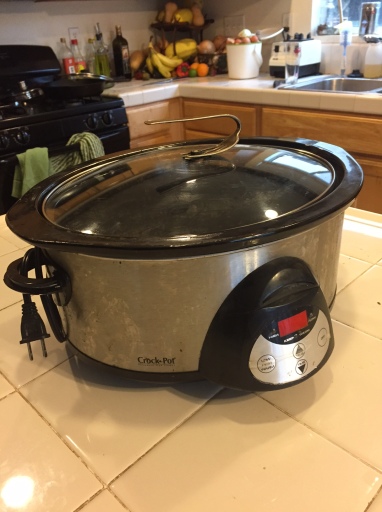
Beat-up slow cooker. The fork lid handle is an upgrade
STORAGE
We like the glass jars, and are increasing our collection, one garage sale at a time, but in the meantime also have plastic bins:
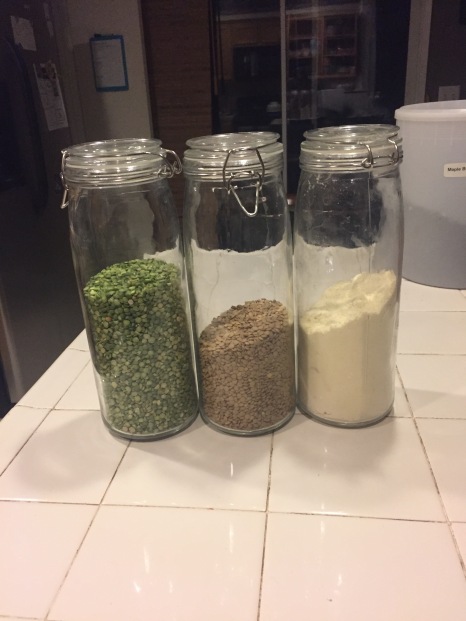
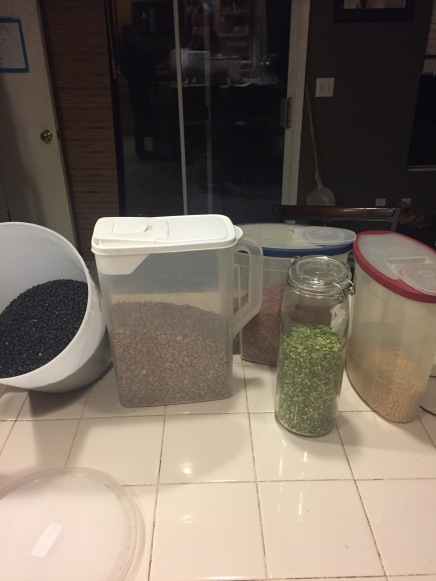
I suppose the challenge is planning. That is to say, “I’m going to be hungry in 6-8 hours from now.” OR “After I eat this sandwich today there is nothing left for lunch tomorrow.” Meal preparation can sometimes be a domesticated backhand to the face that threatens the spontaneity and privilege of having food here and now. But here are some spending stats we’ve tried to estimate:
bean dishes (lentils, black beans, kidney beans,pinto beans, split peas) – $1.50-2.50, many, many servings
One can of beans – $1.50-$2, one serving
One cup of peanuts or sunflower seeds (which would be a lot) – $.35-$.45
Eating at a deli, taco shop, soup place, pizza, etc. – $9-$15, one serving
BEAN SAVINGS
One way to look at it is this:
1 lb (about 2 cups) of dried beans (COST $1.19) =
-makes 6 to 7 cups cooked beans
1 15oz can of cooked beans (COST $1.25-$2.00) =
-1.75 cups when drained, making it equivalent to 1/4 to 1/3 lbs ( or 1/2 to 3/4 cup) dried.
Not only do canned beans cost way more per equivalent dry pound (by roughly 3X to 4X as much), they’re in a can! The dry bulk bean equivalent is about $.30-$.40, compared to a $2 can. Eating canned beans on a weekly basis could really add up.
I’ve had some interesting conversations with people who aren’t interested in “working for their food”. Their salaries usually aren’t bad, per se, but a $12 lunch is not a negligible part of one hour of labor. Even if someone makes $50 an hour, it’s still 25%, and people pay for the privilege of prepared food by working lots and lots of hours. I’ll take my early retirement instead.
GOING NUTS!
Cashews and almonds and walnuts are great, but at roughly $15 a pound we gravitate toward peanuts and sunflower seeds, keeping to our frugal selves. I keep a supply in a cabinet at the office because, no, sometimes oatmeal and fruit isn’t enough food in the morning. Especially after cycling 6 miles.
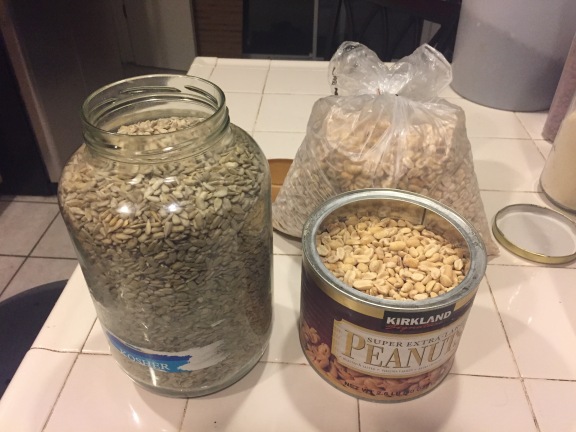
Our nut collection. The tin is actually a reused container.
Peanuts aren’t that expensive, but if you’re buying small containers the cost starts to really add up. A cup is nearly 40 grams of protein, weighs a small portion of a pound.
We also buy our soy beans in bulk to make soy milk.
We buy large oatmeal bags, so breakfast is under a dollar:
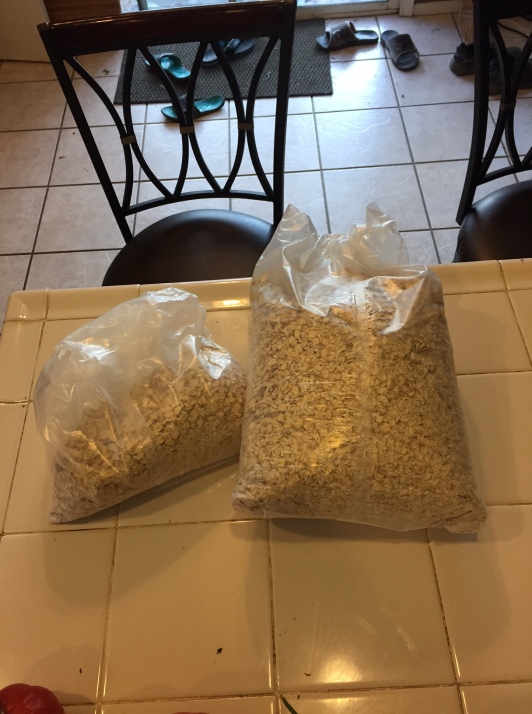
And that’s including the fruit:
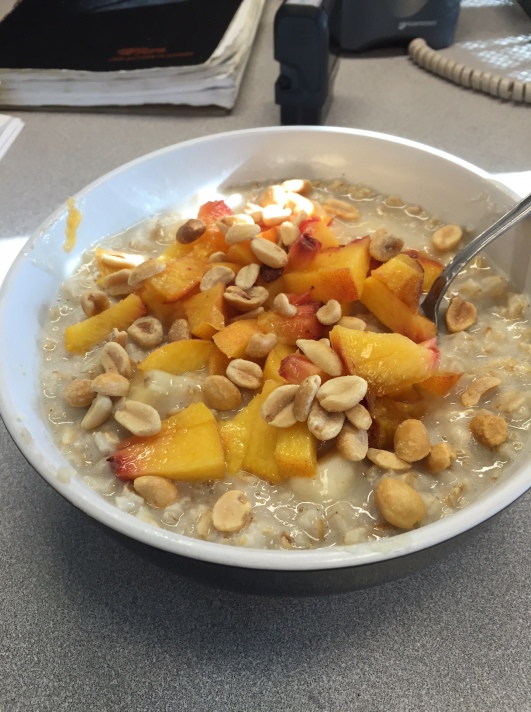
Breakfast at work: oatmeal, one banana, scoop of whey, nectarine, and peanuts.
For the bread, we also keep large flour bins, and buy 50 pound bags for under $20.
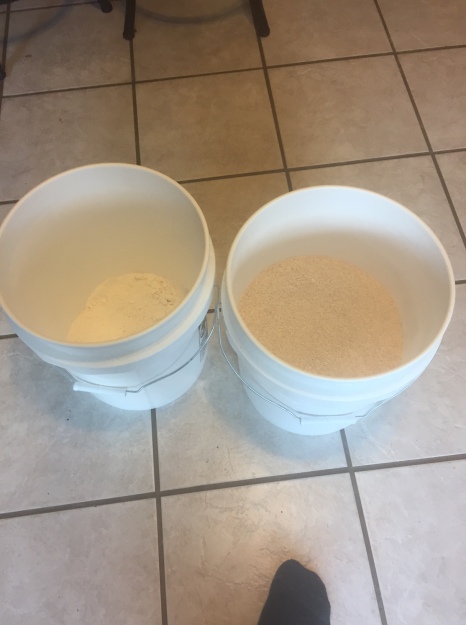
The challenges to buying in bulk is the planning, storage, and perish-ability of food. Aside from setting up a proper storage system, there really isn’t much of a time investment for this initiative. We freeze the nuts. The legumes do seem to last a long time. Onc,e we uncovered kidney beans that were stale after cooking (probably a few years old). We ate them anyway because of course we did. 100% of the grid sustainability is nigh impossible, so we’ve been fortunate to discover/create our bulk enterprise. Cheers.
jh